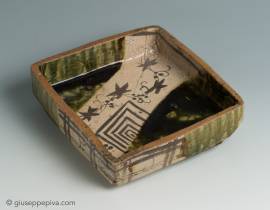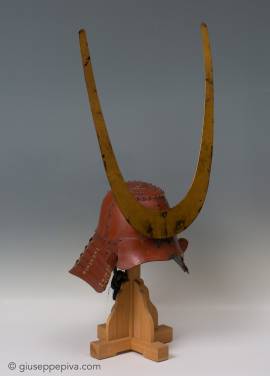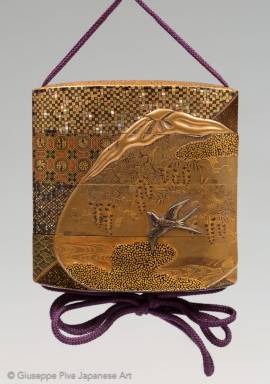Mino Ware, Oribe StyleA green glazed stoneware Oribe footed square serving dish decorated with iron wash grape leaves and geometric patternsMomoyama to Edo period, Early 17th century 20 by 18 by 5.7 cm With a tactile surface texture decorated with an asymmetrical design painted between green-glazed areas, this dish is a typical example of Green Oribe (ao-oribe) ware. The glaze fired to a vivid color flows down to the side walls pooling in rich, deep green lakes at the bottom on two opposite corners and the white strip in between is decorated in a brown iron wash with grape branches...
WORKS FOR SALE
Red lacquered Saika samurai helmetHaruta school, Momoyama period (1573-1615) The Haruta armourers who moved to Kii province in the early 17th century took the name from the village where they worked, Saika, near Wakayama, possibly on request of the local daimyo, Asano Yukinaga, a great armour amateur. Specialized in the construction of plate helmets, they produced few typologies of kabuto. Among them, the most “classical” is made of six large plates with another large one on top shaped as a chrysanthemum; all the plates are joint with rives decorated with washers (za-...
A three-case inrō, 19th centurySigned: JōkasaiHeight: 7.3 cmGold takamaki-e, hiramaki-e, hirame, aogai and metal inlays. Interiors in nashiji. With a large shell from the kai-awase matching game, simulating with various lacquer techniques a painted landscape with a swallow inlaid in shakudo above a river, with pine branches entwined by wisteria. The reverse with another shell seen from the outside. The background decorated with horizontal bands of geometrical diaper patterns on each compartment with different techniques and the rare use of red and green lacquer.Painted shells can be...
Copyright © 2016 - giuseppe piva - VAT: 05104180962










